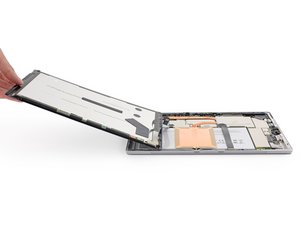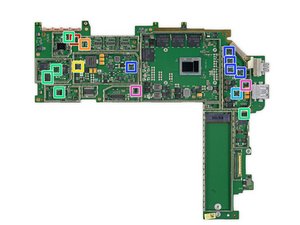By Sam Goldheart • Difficulty: Moderate
Is anyone else getting sick of apples? Time to take a bite out of a juicy Microsoft offering, the Surface Pro 4, to see just what it's made of. Personally, we're hoping Microsoft spent this last year thinking about what they've done and opting for a more fixable laplet (laptop+tablet, eh? ehh?). There's only one way to see inside...okay two ways, we have X-ray vision. It's teardown time!
For the rest of our fall lineup, check out our Facebook, Twitter, and Instagram to be #first.



- With the top-of-the-line model coming in at over $2600, the Surface Pro 4 had better be a cut above the rest—the spec sheet looks promising so far:
- 12.3" PixelSense 2736 × 1824 (267 ppi) IPS LCD display
- Intel Skylake Core m3 (4M Cache, 2.20 GHz) up to Core i7 (8M Cache, 3.80 GHz) CPU
- 4 GB/8 GB/16 GB DDR3L 1600 MHz RAM
- 128 GB/256 GB/512 GB/1 TB of PCIe solid state storage
- 8 MP rear-facing 1080p camera, and 5 MP front-facing camera
- USB 3.0 port, micro-SD slot, mini DisplayPort, and SurfaceConnect charging port
- 802.11a/b/g/n/ac Dual Band Wi-Fi and Bluetooth 4.0



- At first glance, the Surface Pro 4 appears to outshine its predecessors with its forward sensor array.
- We spy at least four nodes of interest. One's a camera, one's probably a microphone, but the rest?
- On the rear of the new Surface, we find a familiar arrangement of circles—the 8 MP rear-facing camera accompanied by a status LED and microphone.
- Anxious to see the camera array but too impatient to open the device? X-ray it.


- That's something we don't see too often—grease! The Pro 4's exposed kickstand hinges are lubricated to meet your transforming computational needs.
- Just try not to get any lint, or pet hair, or sand in there...
- To get such a wide spread of kickstand angles, with the resistance required to support the tablet's weight, Microsoft's engineers probably spent a lot of time on these hinges. So we X-rayed them.



- Sticky nightmares still haunt our teardown engineers after the harrowing Surface Pro 3 teardown, and this year we've prepared for the worst.
- Things start to heat up in the teardown room as the iOpener battles to weaken the display's adhesive.
- Our iSclack joins the fight to provide us the leverage we need to make our entrance, and dare we say it, things seem easier than before.
- Not even a Pro can keep us out. As soon as we get an opening pick underneath the edge of the display it's off to the races!



- Well, these are new. The last time we tore down a Surface Pro, we encountered a display connector trapped beneath a springy metal bracket.
- This time around, there are two cables holding the display to the body, preventing it from being opened like a book on any hinge. Our only recourse: tackle those connectors.
- And of course, Microsoft has modified their connector design. The display connectors are relatively common press-on connectors—similar to an iPhone display—but they're trapped under snap-on metal shields.


- It's not exactly a greeting card, but the underside of the display is adorned with heartfelt-looking barcodes.
- Maybe it's a congratulatory message! More likely, it's proof of some intense quality controls.
- Time for our favorite silicon-based snack—chips! Among them, a number of N-trig IC's, likely control hardware for the Surface Pen.
- N-trig DS-D5000 touchscreen row driver (likely)
- N-trig DS-A5048 touchscreen line driver (likely)
- Macronix MX25U1635F 1.8V 16 Mb MXSMIO serial flash memory



- Turning our attention to the rest of the Pro 4, we spy a suspicious blank space beside the motherboard (and heat sink tubing!).
- The motherboard is so close, yet so far. Unable to wait, we skip to dessert and pop off some shields to get a closer look.
- The rest of the motherboard is nestled too snugly to investigate, but that SSD looks ripe for the picking...



- Oh Surface, look how you've grown!
- The Surface 4's Samsung branded SSD is considerably larger than the little whipper snapper we saw in the previous generation.
- Awww, they brought us more chips. The 128 GB Samsung PM951 SSD is packing the following:
- Samsung S4LN058A01-8030 PCIe 3.0 x4 NVMe flash controller
- Samsung K9CHGY8S5C-CCK0 64 GB NAND flash
- Samsung K4E4E324EE-SGCF 4 Gb (512 MB) DRAM
- Texas Instruments TPS22966 5.5V, 6A, 16mΩ, 2-channel load switch
- Silergy power management (likely)


- The Surface Pro 4's heat sink shows off its impressive makeover, flaunting longer copper heat pipes and a large copper plate for added heat dissipation.
- Designed with a hybrid cooling system, the Pro 4 takes advantage of both passive and active cooling.



- Fittingly, the Surface has a pro line-up of cameras and sensors:
- Infrared emitter
- Infrared camera
- Front-facing camera
- "Privacy light" indicator LED (mounted on the rear-facing camera)
- Microphone
- Ambient light sensor



- Amidst this sea of tech, the tablet's three cameras all float to the surface.
- From left to right:
- Infrared face-detection camera supporting Windows Hello
- Front-facing 5 MP camera
- Rear-facing 8 MP main camera



- We tweeze out the two stereo speakers from the corners of the case and make an interesting discovery...
- The Good: These integrated buttons are much less fidgity to replace as one piece than each button individually.
- The Bad: The entire speaker will have to be replaced to replace one of the buttons, increasing the cost of repair.


- With the peripherals deftly dissected, we can move on to the main event—the motherboard!
- Intel SR2EN Core m3-6Y30 (4M Cache, up to 2.20 GHz)
- Samsung K4E8E304EE-EGCF 8 Gb LPDDR3 (4 chips × 1 GB for a total of 4 GB)
- Marvell Avastar 88W8897 802.11ac, NFC and Bluetooth SoC
- Freescale Kinetis KL17 MKL17Z256VFM4 48 MHz ARM Cortex-M0+
- ITE Tech, Inc. IT8528VG Embedded Controller
- Realtek ALC3269 Audio Codec
- Realtek RTS5304 micro-SD Card Reader Controller


- Chip ID continued...
- Winbond W25Q128FV Serial NOR Flash
- Texas Instruments TPS51367 Integrated FET Converter
- Infineon Technologies SLB96659TT20 Trusted Platform Module
- Monolithic Power Systems MP3388S 50V, 8-String, Step-Up, White LED Driver
- And on the reverse...
- Intersil ISL95857 1+2+1 Voltage Regulator for Intel IMVP8 CPUs
- This huge array of spring contacts connects the motherboard to the battery and the keyboard dock cable.


- IC Identification—even more!
- Bosch Sensortec BMI160 3-Axis Accelerometer/Gyroscope
- Monolithic Power Systems MP2370DGT White LED Driver
- Texas Instruments BQ24770 Battery Charge Controller w/ System Power Monitor
- ON Semiconductor and Winbond Serial Memory
- Texas Instruments TPS51285A Dual-Synchronous Buck Controller
- Texas Instruments TPS62140, TPS62175, TPS62134A, TPS62134C, and TPS62134D Step-Down Converter
- ON Semiconductor NCP380HMUAJAATBG Adj. Current‐Limiting Power‐Distribution Switch


- The iOpener comes out for an encore performance, loosening the tough adhesive that holds the battery in place.
- The battery finally comes loose after a great deal of sweat, tears, and prying.
- :'(


- This 38.2 Wh, 7.5 V battery is rated at 5087 mAh—a 9 percent decrease from the 5547 mAh battery in the Surface Pro 3.
- Despite the smaller battery capacity, the 4 generally outperforms the 3 in terms of battery life.
- Just to compare Apples to oranges, the iPad Air 2 weighs in with a 27.62 Wh battery, however the upcoming iPad Pro is probably a more apt comparison, function-wise. We'll have to wait and see!


- Microsoft Surface Pro 4 Repairability Score: 2 out of 10 (10 is easiest to repair).
- The SSD is replaceable.
- The battery is not soldered to the motherboard, but very strong adhesive makes removal and replacement a hazardous chore.
- Non-standard connectors make for tricky display removal.
- The display removal procedure, while difficult, and required for any repair, is not as hard as in previous generations, due to less stubborn adhesive.
- The display assembly consists of a fused glass panel and LCD, and is difficult to remove and replace.
- Adhesive holds many components in place, including the display and battery.